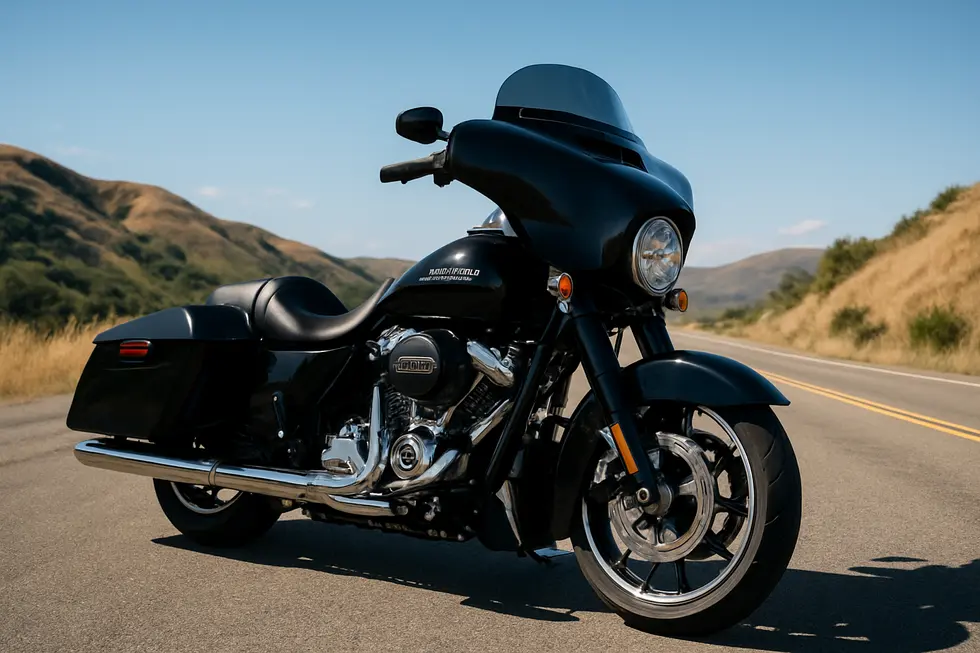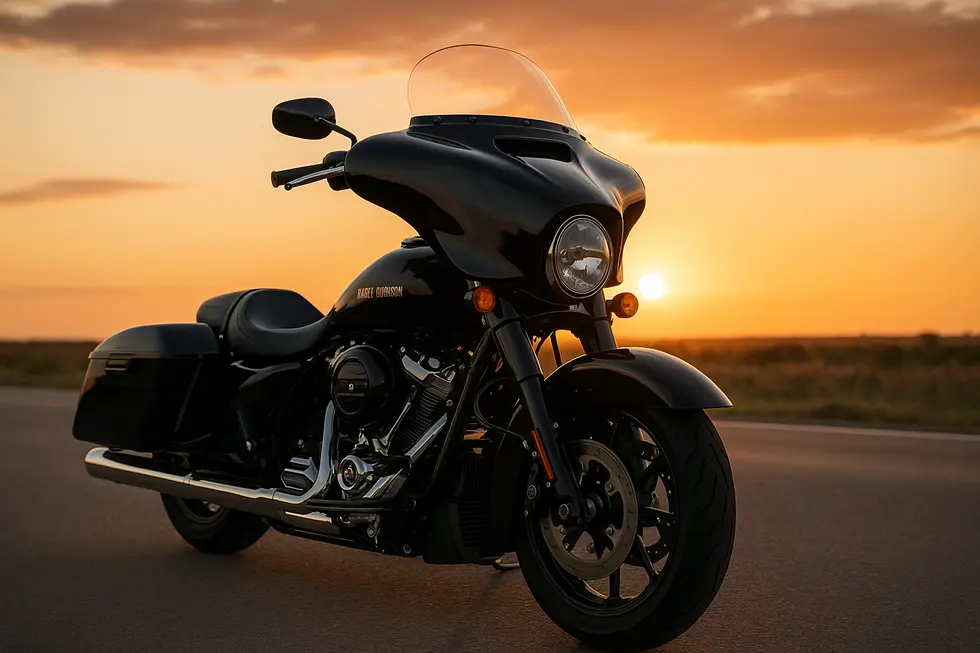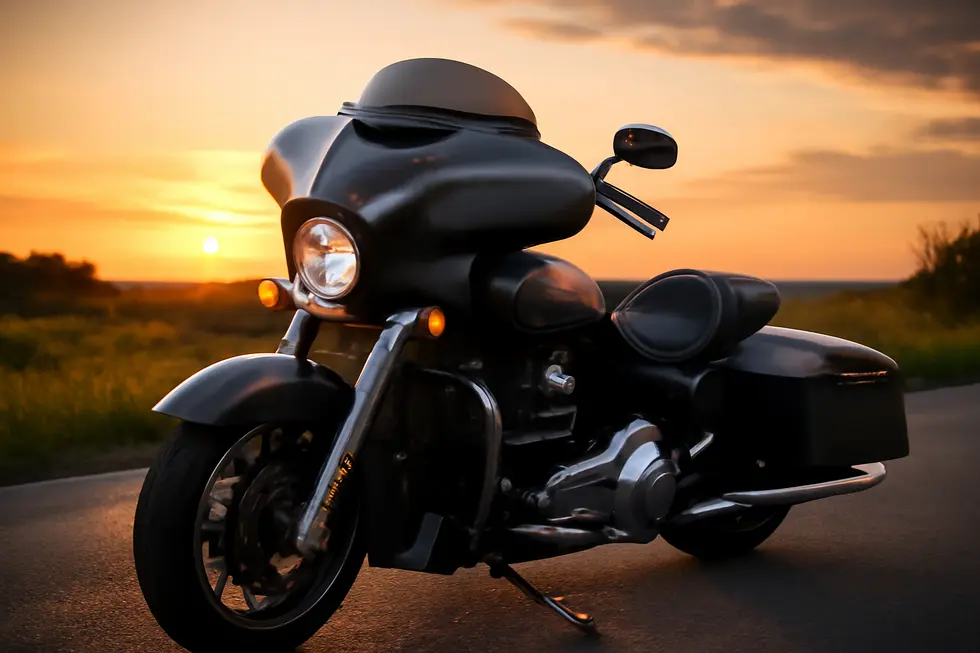The Pioneer Fixed Fairing Motorcycle: Harley-Davidson Road Glide’s Lasting Impact
September 18, 2025 | by summitfairings
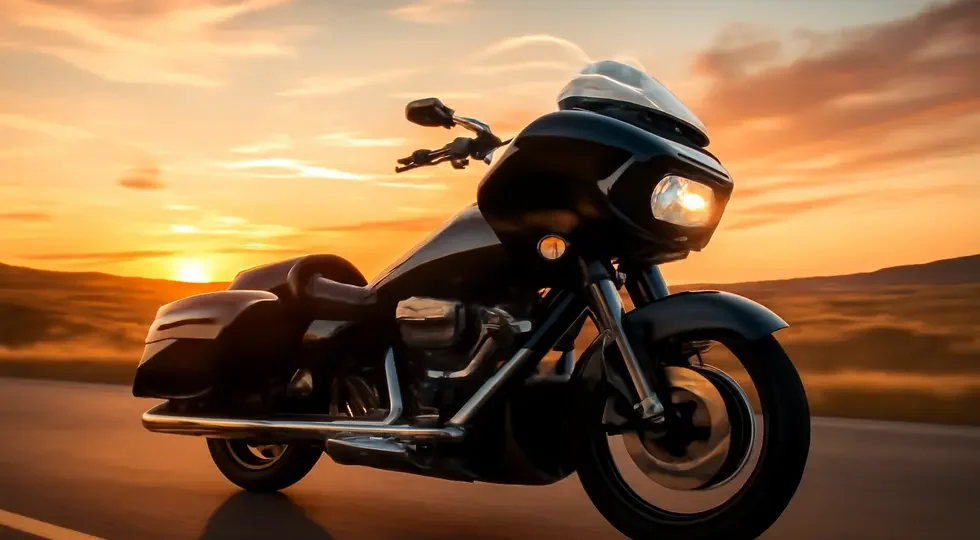
Introduction
The Harley-Davidson Road Glide marked a landmark moment in motorcycle design by pioneering the first widely recognized fixed fairing. This innovative approach, centered around the Road Glide’s distinctive “sharknose” fairing, fundamentally improved aerodynamic efficiency and rider comfort, especially during long-distance touring. Understanding the historical milestones behind this motorcycle, its technical breakthroughs in structure and aerodynamics, and the sweeping effects it has had on touring motorcycle design provides valuable insight into why the Road Glide remains a benchmark for riders and manufacturers alike. Moreover, examining the legacy of the Road Glide reveals how modern advancements, especially in the 2025 Harley-Davidson CVO Road Glide, continue to elevate performance while honoring the fixed fairing’s foundational principles.
Tables of Contents
Chapter 1: Historical Evolution of the First Fixed Fairing Motorcycle: The Harley-Davidson Road Glide
- Engineering Breakthroughs Behind the Road Glide’s Innovative Fixed Fairing Design
- Market Influence and Economic Significance of the Harley-Davidson Road Glide’s Fixed Fairing Innovation
- Geopolitical Dynamics Shaping the Road Glide’s Fixed Fairing Innovation
- Cultural Resonance and Societal Impact of the Harley-Davidson Road Glide’s Fixed Fairing Innovation
Chapter 2: Technical Innovation in the First Fixed Fairing Motorcycle: Structure and Aerodynamics
- Revolutionizing Motorcycle Design: Structural and Aerodynamic Breakthroughs of the Fixed Fairing
- Aerodynamic Engineering and Structural Synergy Enhancing Fixed Fairing Motorcycles
- Aerodynamic Heat Control and Ergonomic Comfort in Fixed Fairing Motorcycle Design
- Elevating Material Efficiency and Handling Stability through Structural and Aerodynamic Synergy
Chapter 3: Impact of the First Fixed Fairing Motorcycle on Touring Motorcycle Design and Rider Comfort
- Revolutionizing Aerodynamics: How the First Fixed Fairing Enhanced Touring Performance and Comfort
- How Fixed Fairings Revolutionized Wind Protection and Stability for Enhanced Touring Comfort
- Ergonomic Evolution and Enhanced Rider Comfort Shaped by the First Fixed Fairing Motorcycle
- How Aerodynamics and Ergonomics Revolutionized Touring with the Fixed Fairing
Chapter 4: Legacy and Modern Advancements in the First Fixed Fairing Motorcycle: The 2025 Harley-Davidson CVO Road Glide
- Seamless Fusion of Heritage Design and Cutting-Edge Technology in the 2025 Fixed Fairing Motorcycle
- Revolutionizing Highway Performance: Engine Mastery and Dynamic Enhancements in the 2025 CVO Road Glide
- Advanced Safety and Handling: Seamless Integration of Aerodynamics and Technology in the 2025 Fixed Fairing Motorcycle
- Economic Influence and Market Resonance of the 2025 Harley-Davidson CVO Road Glide’s Fixed Fairing Innovation
Chapter 1: Historical Evolution of the First Fixed Fairing Motorcycle: The Harley-Davidson Road Glide
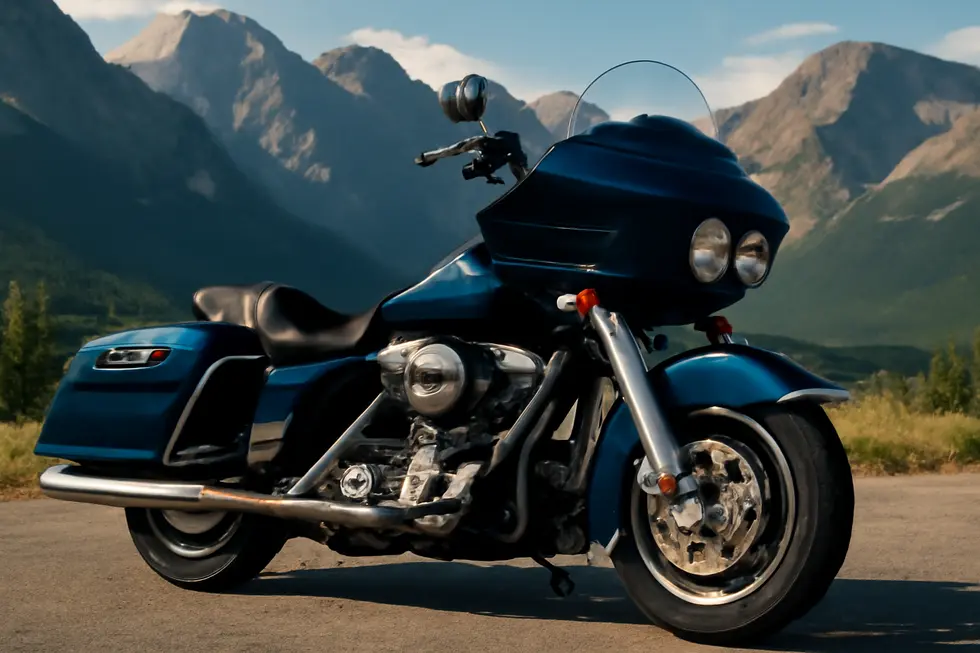
1. Engineering Breakthroughs Behind the Road Glide’s Innovative Fixed Fairing Design
The Harley-Davidson Road Glide revolutionized touring motorcycles with its introduction of the fixed fairing, marking a pivotal advancement in rider comfort and aerodynamic efficiency. Unlike traditional handlebar-mounted fairings, the Road Glide’s rigidly frame-attached “sharknose” fairing isolates wind forces from steering, dramatically reducing buffeting at high speeds and enhancing stability. This innovation traces its roots through decades of Harley-Davidson engine and chassis refinement, from the powerful Shovelhead era to the modern Milwaukee-Eight powerplants that balance torque, cooling, and emissions with classic V-twin character.
Significant progress arrived with initiatives like Project RUSHMORE, which incorporated improved aerodynamics, higher-output engines, and advanced six-speed transmissions, all curated to optimize long-distance rideability. Recent models continue this trend, featuring Variable Valve Timing and lightweight materials combined with signature styling cues. Integrated technologies—such as LED lighting and sophisticated audio systems—further elevate the Road Glide’s touring capabilities, reflecting seamless fusion of tradition and innovation.
By anchoring the fairing directly to the frame, Harley-Davidson set a new standard in motorcycle design focused on enduring comfort and performance, influencing subsequent touring models industry-wide. These advancements underscore the brand’s commitment to engineering motorcycles that truly meet the demands of dedicated riders.
Discover more about the evolution of motorcycle aerodynamic parts at Explore the Best Motorcycle Fairings at Summit Fairings.
2. Market Influence and Economic Significance of the Harley-Davidson Road Glide’s Fixed Fairing Innovation
The introduction of the fixed “Sharknose” fairing on the Harley-Davidson Road Glide marked a pivotal moment in the brand’s economic and market trajectory. Emerging in the late 1990s, this distinctive design not only redefined touring motorcycle aerodynamics but also reinforced Harley-Davidson’s foothold in a competitive landscape increasingly influenced by advanced Japanese imports. By anchoring the fairing to the frame instead of the handlebars, the Road Glide delivered superior stability and reduced wind buffeting, enhancing rider comfort during long-distance journeys — a critical factor for touring enthusiasts. This functional innovation appealed strongly to a demographic that valued tradition blended with modern performance, enabling Harley to differentiate itself within the premium touring segment. Over the decades, models evolved to integrate cutting-edge technologies, including powerful VVT engines and high-end finishes in limited-edition releases, thus expanding Harley’s global appeal and sales resilience. This economic vitality supported Harley-Davidson’s sustained leadership in the touring motorcycle market, proving that embracing design evolution while preserving brand identity could effectively navigate shifting consumer preferences. Overall, the Road Glide’s fixed fairing symbolizes a strategic convergence of aerodynamic advancement and market savvy, underpinning Harley-Davidson’s cultural and commercial significance in motorcycling history. For riders and enthusiasts seeking comprehensive insights, exploring the wide variety of premium motorcycle fairings available today offers an informative perspective on how this legacy continues to influence modern design choices. [1]
3. Geopolitical Dynamics Shaping the Road Glide’s Fixed Fairing Innovation
The development of the Road Glide’s distinctive fixed fairing reflects complex geopolitical influences intertwined with global industrial trends and market pressures. During the mid-20th century, Harley-Davidson faced intense competition from technologically advanced Japanese manufacturers, who disrupted traditional markets with affordable, reliable motorcycles. This spurred Harley-Davidson to innovate, leading to the Road Glide’s fixed fairing designed for superior aerodynamic stability and rider comfort on long-distance tours—an edge amid rising global competition.
Post-World War II economic conditions initially favored American manufacturing dominance, but globalization soon amplified foreign competition, pushing Harley-Davidson to modernize engines and adopt stricter emission-related technologies. The transition from earlier engines to the Milwaukee-Eight model was not only technical advancement but a response to tightening international environmental regulations, shaping the motorcycle’s design and performance.
Simultaneously, Harley-Davidson capitalized on its role as an icon of American resilience during geopolitical tensions, blending cultural symbolism with engineering progression to maintain both domestic loyalty and global appeal. This blend of market-driven innovation and geopolitical branding helped the Road Glide’s fixed fairing become a pioneering feature, balancing heritage with the demands of a dynamic global motorcycle industry.
Explore more about the evolution of motorcycle fairings and their role in enhancing ride performance at Summit Fairings’ blog.
4. Cultural Resonance and Societal Impact of the Harley-Davidson Road Glide’s Fixed Fairing Innovation
The Harley-Davidson Road Glide’s pioneering fixed fairing signified more than a technical breakthrough; it became a cultural emblem within American motorcycling. Emerging in the mid-1990s, this fixed fairing redefined touring motorcycles by enhancing rider comfort and stability on highways, aligning with the growing societal embrace of long-distance leisure riding. Unlike earlier fork-mounted fairings, its direct frame attachment reduced wind buffeting, making extended journeys more enjoyable. This innovation resonated deeply with Harley-Davidson’s core values, symbolizing freedom, rugged individualism, and the open road ethos central to biker identity.
The fixed fairing’s bold, aggressive styling quickly turned it into a visual icon among riders, fostering a sense of community and shared lifestyle. Harley-Davidson’s integration of tradition and cutting-edge performance in the Road Glide reinforced its role not only as a motorcycle manufacturer but as a cultivator of culture, exemplified by the Harley Owners Group’s enthusiastic embrace. This model encapsulates the historical evolution from classic engine designs to modern powertrains, highlighting the brand’s dedication to blending heritage with innovation.
Ultimately, the Road Glide’s fixed fairing stands as a cultural artifact reflecting broader shifts in American mobility, leisure, and identity. Its design advanced touring motorcycle comfort and safety while reinforcing Harley-Davidson’s enduring image as a symbol of freedom and community within biker culture. For those interested in exploring the significance of motorcycle design innovations, the explore Summit Fairings—your go-to destination for motorcycle fairings offers valuable insights.
Chapter 2: Technical Innovation in the First Fixed Fairing Motorcycle: Structure and Aerodynamics
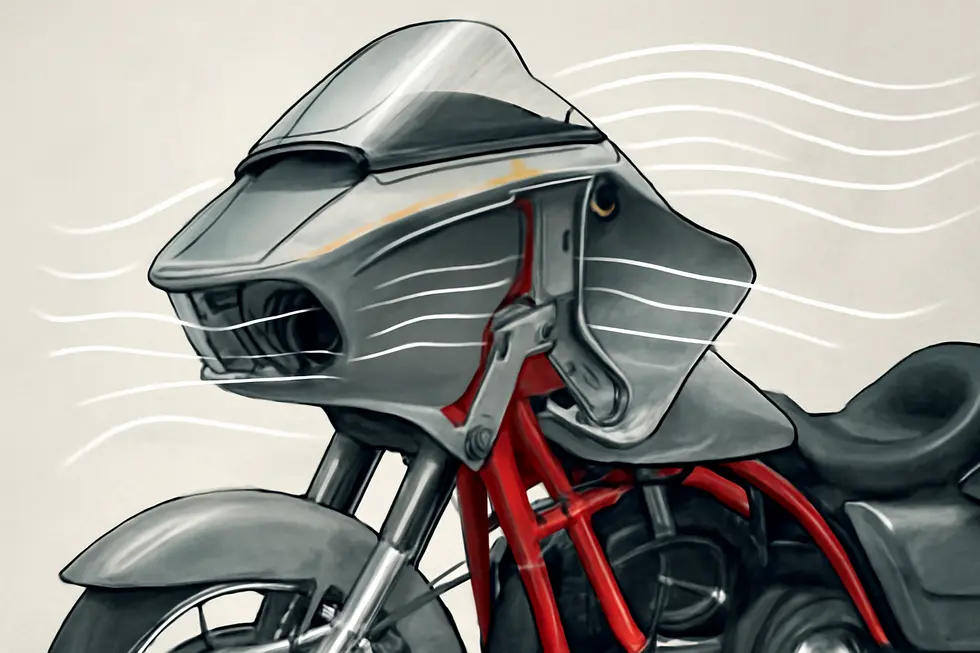
1. Revolutionizing Motorcycle Design: Structural and Aerodynamic Breakthroughs of the Fixed Fairing
The introduction of the fixed fairing marked a transformative leap in motorcycle engineering by relocating the fairing from handlebar mounts directly onto the frame. This pivotal structural shift enhanced chassis rigidity, eliminating the instability and steering interference common with traditional handlebar-mounted fairings. Firmly anchored to the motorcycle’s frame, the fixed fairing offers a stable aerodynamic platform that remains unaffected by steering inputs, enabling designers to employ advanced computational fluid dynamics (CFD) to optimize airflow.
This enhanced aerodynamic shaping directs air efficiently around critical components like the front wheel and rider, significantly reducing wind buffeting and drag. The streamlined design channels airflow smoothly over integrated elements such as headlights and mirrors, which improves overall aerodynamic performance and high-speed stability. Riders experience less fatigue and greater comfort due to diminished turbulence, a key advantage for long-distance touring.
By marrying structural integrity with precision-engineered aerodynamics, the fixed fairing set a new performance standard. This integration boosts handling stability, fuel efficiency, and rider experience without compromising durability. The ongoing evolution of frame-mounted fairings underscores their role as a hallmark of touring motorcycle innovation. For those interested in exploring the variety and benefits of such design, discovering unmatched motorcycle fairings at Summit Fairings offers valuable insights.
2. Aerodynamic Engineering and Structural Synergy Enhancing Fixed Fairing Motorcycles
The technical innovation behind fixed fairing motorcycles hinges on harmonizing aerodynamic refinement with structural design to elevate performance and rider comfort. Central to this evolution is the sculpting of the fairing into a streamlined shape that channels airflow efficiently, creating a protective pocket of calm air around the rider. This reduces drag and limits turbulence, decreasing fatigue on long rides while boosting stability at high speeds. Advanced aerodynamic elements, such as integrated winglets and spoilers, strategically generate downforce. This additional load increases tire traction during cornering without sacrificing straight-line speed. Leveraging computational fluid dynamics (CFD) simulations combined with rigorous real-world testing allows engineers to optimize every contour. Inspired by MotoGP innovations, features like air deflectors enhance engine cooling without compromising aerodynamic flow. Meanwhile, lightweight carbon fiber materials reduce overall weight and chassis flex, sharpening handling and responsiveness. Ground effect principles further augment vertical load, especially when leaning into curves, dramatically improving grip and control. Together, these aerodynamic optimization techniques and structural advancements form a cohesive system that sets a new standard for fixed fairing motorcycles. For deeper insights into contemporary aerodynamic breakthroughs, detailed technical reviews such as the Ducati Panigale V4 are invaluable resources.
3. Aerodynamic Heat Control and Ergonomic Comfort in Fixed Fairing Motorcycle Design
The revolutionary fixed fairing design transformed heat management and rider comfort by harmonizing aerodynamic efficiency with thoughtful ergonomics. By rigidly attaching the fairing to the motorcycle frame, airflow is precisely controlled to form a protective, low-turbulence bubble around the rider. This reduces the relentless impact of engine heat and turbulent wind, significantly improving thermal comfort during long-distance riding. Advanced aerodynamic shaping not only lowers drag but strategically channels cooler air towards critical engine cooling components, enhancing heat dissipation without sacrificing stability.
Innovations such as integrated radiator conveyors and mudguards optimize heat exchange in the cooling circuits, ensuring the engine runs cooler under demanding conditions while maintaining rider comfort. Complementing thermal management, the fixed fairing’s sculpted design expands rider space and supports various riding postures, including aggressive cornering techniques. This ergonomic focus ensures comfort and control are preserved over extended journeys and high-speed touring.
These advances illustrate how the fusion of structure and aerodynamics tackles both mechanical heat challenges and human factors. Modern benchmarks carry forward this legacy, highlighting fixed fairings as pivotal in delivering balanced performance, reducing wind fatigue, and enhancing rider endurance. For an in-depth look at aerodynamic and thermal advancements in premier fixed fairing motorcycles, explore this detailed resource on Ducati Panigale V4 aerodynamics and heat management.
4. Elevating Material Efficiency and Handling Stability through Structural and Aerodynamic Synergy
The breakthrough in the first fixed fairing motorcycles lies in balancing material efficiency with enhanced handling stability, creating a cohesive engineering achievement. Lightweight materials such as aluminum steer the design of forks and steering components, reducing overall weight without sacrificing strength. Frames commonly utilize mild steel tubular construction with forged and stamped junctions, maximizing the strength-to-weight ratio. Some models adopt integrated chassis systems where the engine functions as a load-bearing component, trimming excess frame mass while retaining stiffness. Aerodynamics play a pivotal role; computational fluid dynamics (CFD) guides the shaping of fairings to streamline airflow and minimize drag, generating a stable air pocket that reduces rider buffeting and enhances comfort. This results in improved straight-line stability at high speeds. The chassis and suspension geometries are precisely tuned to deliver neutral cornering response and responsive feedback, ensuring confident handling in various riding conditions. Additionally, thermal management is addressed through strategic venting that channels heat away from the rider, elevating comfort without compromising structural integrity. Together, these intertwined innovations in materials, structural design, and airflow management elevate the performance and comfort of the pioneering fixed fairing motorcycles, setting new standards for touring motorcycle engineering. For further insight into fairing designs and options, explore the best motorcycle fairings at Summit Fairings. More detailed technical analysis can be found at the Ducati Panigale V4 structure and aerodynamics page.
Chapter 3: Impact of the First Fixed Fairing Motorcycle on Touring Motorcycle Design and Rider Comfort
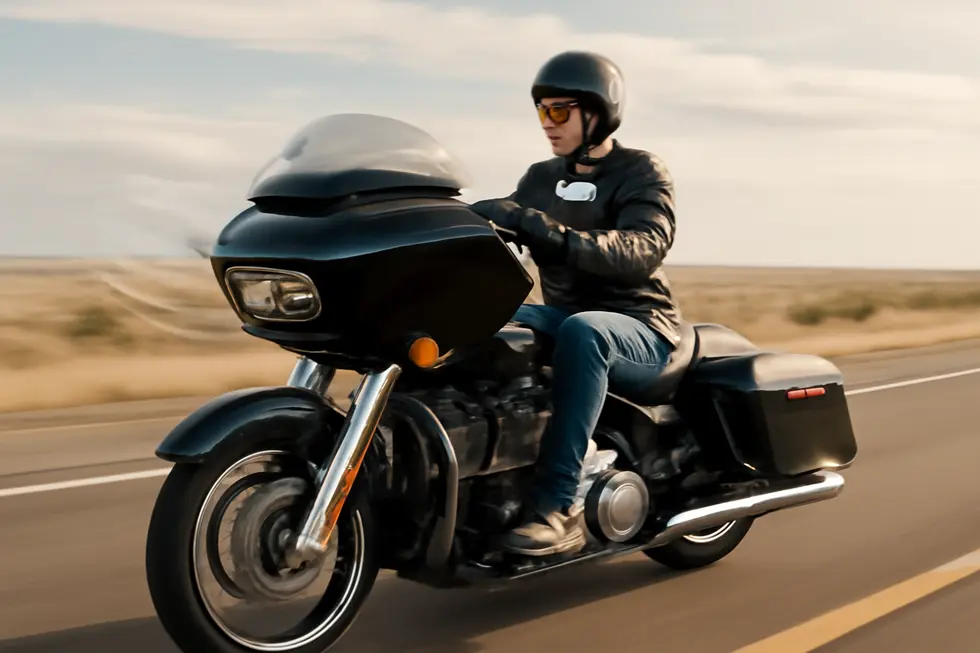
1. Revolutionizing Aerodynamics: How the First Fixed Fairing Enhanced Touring Performance and Comfort
The introduction of the first fixed fairing marked a transformative leap in touring motorcycle aerodynamics, fundamentally reshaping design priorities and rider experience. Rigidly mounted to the frame, unlike previous handlebar-mounted or minimal windshields, the fixed fairing streamlined airflow dramatically, reducing wind resistance and drag. This advancement not only improved high-speed stability but also lessened engine strain, enabling more efficient cruising over long distances. With air deflected smoothly around the motorcycle and rider, buffeting was minimized, substantially decreasing rider fatigue and enhancing comfort during extended journeys.
Structurally, the fixed fairing prompted engineers to reconsider frame geometry, weight distribution, and cooling methods to optimize airflow and mechanical function. Improved weather protection became a key benefit: riders found refuge from rain, cold, and flying debris, further extending touring capability. Noise levels also dropped as turbulent airflow around helmets and shoulders softened, allowing riders a calmer, less stressful ride.
Additionally, adjustable vents integrated into fairings allowed personalized airflow control, aligning comfort with variable conditions. The principles set by early fixed fairings persist in modern touring motorcycles, which balance aerodynamic efficiency with ergonomic function and weather shielding. This legacy underscores the enduring impact of aerodynamic innovation on motorcycle touring comfort and performance. For more insight into advanced designs, consult this resource on exploring efficient motorcycle fairings.
External reference: https://www.polaris.com/es-us/news/product/indian-motorcycle-delivers-most-powerful-engine-in-its-class/
2. How Fixed Fairings Revolutionized Wind Protection and Stability for Enhanced Touring Comfort
The innovation of fixed fairings marked a pivotal advancement in touring motorcycle design by reshaping wind protection and rider stability. Unlike earlier setups, fixed fairings create a stable aerodynamic envelope around the rider, dramatically reducing the impact of wind buffeting and resistance at highway speeds. This refined airflow management eases physical strain, allowing riders to maintain focus and comfort over extended journeys. The fixed fairing also enhances stability by generating downforce that improves front-end grip, minimizing wheel lift and unwanted movement during cornering and braking, which leads to safer and more confident handling without over-reliance on electronic aids.
Beyond performance, these fairings improve ergonomics by channeling air away from sensitive areas, supporting controlled riding positions ideal for long-distance touring. Moreover, modern designs optimize thermal management through carefully placed vents that complement aerodynamic gains without compromising engine cooling. This synergy between aerodynamic efficiency and rider comfort has set a new benchmark in motorcycle design, fostering a riding experience that balances speed, control, and endurance.
The evolution initiated by early fixed fairing motorcycles laid the groundwork for today’s sport-tourers, combining advanced wind deflection and stability with ergonomic versatility. For more about fairing innovations and choices catering to varied riding needs, explore this extensive resource on motorcycle fairings.
For a detailed example of aerodynamic benefits and stability, see the Ducati Panigale V4’s winged fairing design which reduces drag and increases front-end downforce for unparalleled control. Learn more here.
3. Ergonomic Evolution and Enhanced Rider Comfort Shaped by the First Fixed Fairing Motorcycle
The advent of the first fixed fairing motorcycle transformed touring design by directly addressing rider comfort through aerodynamic and ergonomic breakthroughs. Fixed fairings create a stable windscreen that dramatically reduces wind buffeting, forming a protective “bubble” of calm air. This breakthrough minimizes fatigue caused by continual wind pressure, allowing riders to endure longer journeys with greater ease. Beyond wind protection, ergonomic design evolved alongside fixed fairings to harmonize rider posture with aerodynamic flow. Thoughtful seating and tank contours provide firm support during braking and cornering, reducing arm strain and enhancing control. Adjustable elements such as seat height, handlebar positioning, and suspension tuning further personalize comfort, adapting to individual rider needs and terrain demands. Together, these refinements extend endurance and precision in riding, marking a significant shift toward optimized long-distance travel comfort and handling. This progression from early fixed fairings to today’s sophisticated ergonomic integration highlights the ongoing commitment to balancing performance with rider wellbeing. For riders exploring options, a variety of specialized motorcycle fairings exist to enhance this experience, detailed further in resources like this guide to motorcycle fairings.
For more depth on ergonomic design in sport-touring motorcycles, studies show how rider-knee anchoring and seat-tank shaping improve dynamic stability and comfort[^2]. Similarly, touring models emphasize adjustable setups to tailor comfort and control on extended rides[^4]. These innovations collectively set new standards for rider satisfaction and touring capability.
[^2]: Detailed ergonomic studies on sport-touring ergonomics.
[^4]: Technical reviews on adjustable touring motorcycle components.
4. How Aerodynamics and Ergonomics Revolutionized Touring with the Fixed Fairing
The introduction of fixed fairings marked a transformative moment in touring motorcycle design by seamlessly marrying aerodynamic efficiency with rider-centered ergonomics. Unlike handlebar-mounted fairings, fixed fairings are rigidly attached to the frame, creating a stable aerodynamic envelope that significantly reduces wind buffeting and lowers rider fatigue on long journeys. This design innovation generates beneficial downforce, enhancing high-speed stability and minimizing front-wheel lift during rapid acceleration or braking, which translates into greater rider confidence and control.
Beyond aerodynamics, the fixed fairing architecture allows designers to optimize rider posture by balancing wind protection with comfort, crucial for extended touring. Ergonomic fine-tuning encourages a relaxed riding position while maintaining excellent handling dynamics. These advances not only improved performance but also set new standards for rider comfort and safety.
Modern touring motorcycles continue to build on this legacy, incorporating sophisticated aerodynamic elements such as winglets and advanced cooling systems to further enhance stability and engine efficiency. Coupled with ergonomic features like electronic cruise control and refined chassis geometry, these innovations demonstrate the enduring impact of the fixed fairing concept.
For enthusiasts seeking deeper insights into fairing designs and their benefits, resources like the Summit Fairings blog offer extensive information. Additionally, aerodynamic and stability advancements seen in contemporary sport-tourers exemplify the continued evolution driven by this foundational integration of technology and functional design (see details on advanced aerodynamic features here).
Chapter 4: Legacy and Modern Advancements in the First Fixed Fairing Motorcycle: The 2025 Harley-Davidson CVO Road Glide
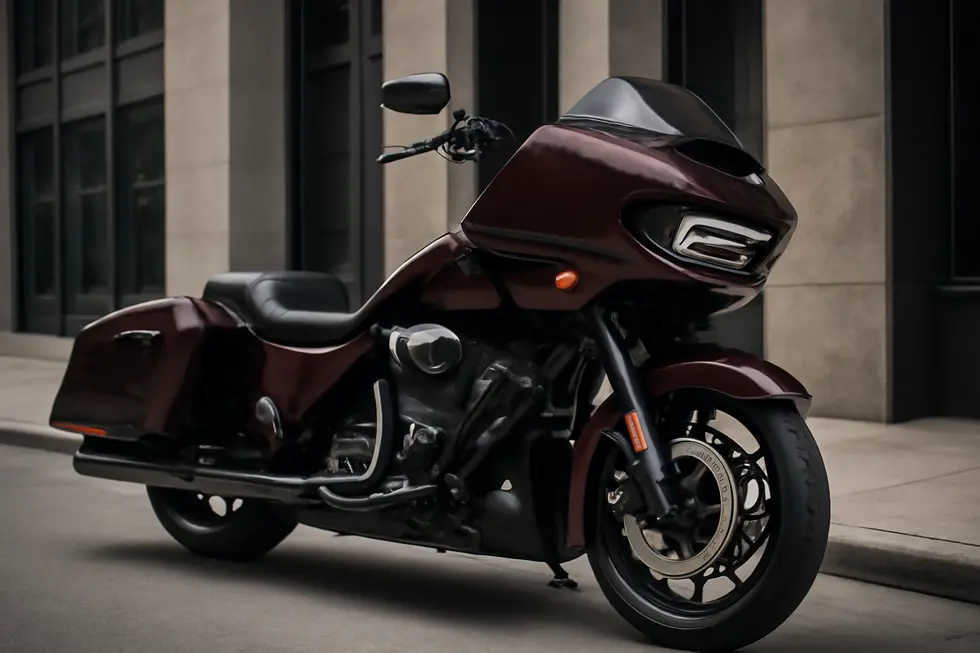
1. Seamless Fusion of Heritage Design and Cutting-Edge Technology in the 2025 Fixed Fairing Motorcycle
The 2025 model exemplifies a masterful blend of heritage and innovation, preserving the fixed “sharknose” fairing that defines its lineage. This iconic design has been refined through computational fluid dynamics to enhance aerodynamic efficiency and significantly reduce wind buffeting, ensuring rider comfort on long journeys. Complementing its aerodynamic prowess, the model integrates modern LED lighting seamlessly into the fairing, improving visibility while maintaining a bold stylistic identity.
Powering this iteration is a robust Milwaukee-Eight VVT 121 engine, the largest displacement offered in Harley-Davidson’s touring range. The incorporation of liquid-cooled cylinder heads paired with variable valve timing delivers smooth power across all RPMs, optimizing fuel efficiency without sacrificing performance. To further elevate ride quality, advanced suspension components such as 47mm inverted front forks and asymmetric rear shocks with quick preload adjustment offer a balanced combination of handling precision and comfort.
Infotainment advances reflect a shift toward connected mobility, featuring a large 12.3-inch full-color TFT touchscreen running the Skyline™ OS. Wi-Fi enabled navigation with real-time map updates and seamless integration with wireless communication devices enrich the touring experience, all while prioritizing safety and minimizing distractions. This model stands as a modern testament to a legacy where aerodynamic innovation and rider-focused technology converge.
For more insights into custom motorcycle fairings, explore a vast selection of premium styles.
Official detailed specifications are available through Skyline Harley-Davidson’s documentation on the 2025 CVO Road Glide.
2. Revolutionizing Highway Performance: Engine Mastery and Dynamic Enhancements in the 2025 CVO Road Glide
The 2025 Harley-Davidson CVO Road Glide exemplifies the evolution of fixed fairing motorcycles through groundbreaking engine innovations and refined performance features. Powered by the formidable Milwaukee-Eight® VVT 121 engine, it delivers a commanding 127 horsepower paired with 145 ft-lb of torque, marking the highest displacement ever factory-installed on a Harley touring bike. Incorporating variable valve timing, liquid-cooled cylinder heads, and an enhanced intake tract, the powertrain balances robust output with improved fuel efficiency. This mechanical prowess is complemented by a redesigned sharknose fairing, refined through computational fluid dynamics to optimize aerodynamics and rider comfort while preserving its iconic silhouette. High-performance suspension further elevates ride quality, featuring fully adjustable SHOWA® 47mm inverted front forks and dual outboard remote reservoir shocks, allowing tailored tuning for diverse road demands. The integration of cutting-edge electronics via the Skyline™ OS and a vivid 12.3-inch TFT touchscreen introduces wireless Apple CarPlay®, Bluetooth, and over-the-air updates, redefining rider interaction and safety. The CVO Road Glide RR variant pushes boundaries with the Screamin’ Eagle® 131 powertrain, outputting 153 horsepower and race-grade transmission components for enhanced durability. Together, these advancements highlight a significant leap from early fixed-fairing models, reflecting a harmonious blend of tradition and modern engineering that sets new standards in touring motorcycle performance. For further details on these technological strides, see Heart of Dixie HD – FLTRXSTSE CVO Road Glide ST. To explore premium aerodynamic components that complement such cutting-edge motorcycles, visit our post on explore the best motorcycle fairings at Summit Fairings.
3. Advanced Safety and Handling: Seamless Integration of Aerodynamics and Technology in the 2025 Fixed Fairing Motorcycle
The 2025 Harley-Davidson CVO Road Glide exemplifies a masterful fusion of its signature fixed sharknose fairing with contemporary safety and handling innovations. Its frame-mounted aerodynamic fairing significantly reduces wind buffeting and enhances stability during high-speed touring, directly improving rider comfort and control over long distances. Building on this legacy, the motorcycle incorporates advanced traction control systems—specifically the Drag-Torque Slip Control System and Cornering Drag-Torque Slip Control System—that actively prevent wheel slip, even in leaned cornering situations, thereby elevating rider confidence and safety across varied road conditions.
Complementing these features is a sophisticated infotainment interface powered by Skyline™ OS. This system offers seamless wireless connectivity and real-time navigation, minimizing distraction so riders can maintain focus on the road. Ergonomic refinement is evident in the thoughtfully designed seat options and a chassis built from a mild steel tubular backbone frame complemented by durable cast and forged junctions. This construction balances robustness with agility, sustaining precise handling throughout touring demands.
Powering this responsive setup is a high-performance 153-horsepower Screamin’ Eagle® engine paired with a racing-grade transmission, delivering both control and exhilarating performance. Together, these elements embody a holistic approach where aerodynamic tradition meets modern technology, advancing safety and handling standards in the pioneering fixed fairing segment. For more insight into cutting-edge motorcycle fairings, explore the unmatched selections available at Summit Fairings.
North Country Harley-Davidson Details on CVO Road Glide ST provides further specifications on electronic safety systems and frame innovation.
4. Economic Influence and Market Resonance of the 2025 Harley-Davidson CVO Road Glide’s Fixed Fairing Innovation
The 2025 Harley-Davidson CVO Road Glide brilliantly merges its iconic fixed sharknose fairing with state-of-the-art technology, creating a commanding presence in the premium touring motorcycle segment. By integrating aerodynamic refinements developed through computational fluid dynamics, this model not only honors its legacy but dramatically improves rider comfort and efficiency at high speeds. At its core, the Milwaukee-Eight VVT 121 engine stands as Harley-Davidson’s largest and most advanced powertrain on a touring bike, delivering exceptional power and torque coupled with fuel efficiency enhancements. High-performance components like Brembo brakes and SHOWA suspension contribute to an elevated riding experience, justifying its positioning in the high-end market.
This combination appeals profoundly to seasoned motorcycle enthusiasts willing to invest in superior machines, bolstering Harley-Davidson’s profitability. On the market front, the integration of the Skyline™ OS infotainment system with a crisp 12.3-inch TFT touchscreen and seamless wireless connectivity addresses modern rider expectations, bridging tradition with contemporary convenience. The CVO Road Glide RR variant intensifies this appeal by introducing race-inspired performance parts and the powerful Screamin’ Eagle 131 engine, attracting riders who seek premium power and handling in touring motorcycles.
Together, these factors enhance the brand’s prestige and market share, solidifying its role as an innovator that respects its storied past while advancing motorcycle engineering. More details on specs and features can be found in this detailed overview. For those interested in exploring tailored fairing options that complement such premium bikes, consider visiting affordable motorcycle fairings at Summit Fairings.
Final thoughts
The Harley-Davidson Road Glide’s introduction of the first widely recognized fixed fairing set a new standard in motorcycle touring design. By anchoring the distinctive sharknose fairing directly to the frame, it achieved a breakthrough in reducing wind buffeting and enhancing aerodynamic stability. This innovation not only boosted rider comfort but also influenced how touring motorcycles have been engineered since. Today, the legacy lives on through models like the 2025 Harley-Davidson CVO Road Glide, which combines classic design philosophy with cutting-edge technology, underscoring the timeless value of the fixed fairing concept. For business owners operating in motorcycle-related industries, understanding this evolution offers insight into consumer priorities and product innovation that continue to shape market trends.
Ready to elevate your ride? Summit Fairings delivers premium, custom-fit fairings that blend style and durability. Whether you’re chasing speed or turning heads, we’ve got your bike covered. Don’t wait—transform your machine today. Click, customize, and ride with confidence. Your perfect fairing is just a few clicks away. Act now!
About us
undefined
RELATED POSTS
View all

